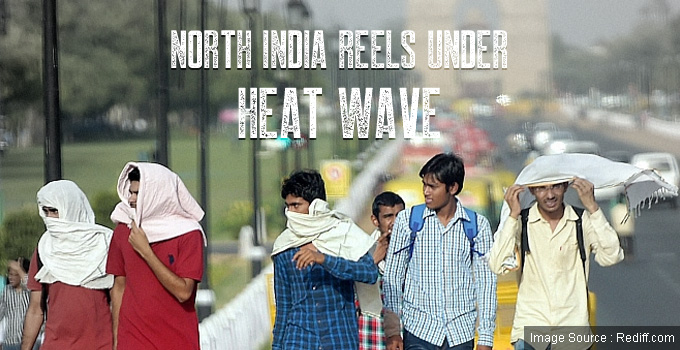Temperatures hovered above 45 degree Celsius on 4 June 2017, the highest this season, in most of the states of North India. It is summer time and North India is once again experiencing a heat wave. This time, it is on an average 4 to 5 degrees more than the previous years’ maximum temperatures. This heat wave is likely to continue for the next few days, though there is a likelihood of rain and thundershowers bringing relief, as per the Meteorological Department.
Worst Affected Regions in North India
In a majority of the cities of North India, the maximum temperature was above the normal temperature. In Delhi, it was 4 degrees above normal recording the highest at 47 degree this season on Sunday. In Uttar Pradesh also, most of the regions recorded the highest temperature this season. Rajasthan is another state where the heat wave has engulfed a major part of the state, including Jaipur, Bikaner, Sawai Madhopur, Jaisalmer and Jodhpur.
Even the hill stations in North India have not been spared. Shimla and Una in Himachal Pradesh and Jammu recorded highest temperatures of the season. The maximum in Shimla was 30.1 degrees and Una was 44.8 degrees Celsius on Sunday while Jammu recorded 43.3 degrees.
The badly affected regions in North India on 4 June are as follows:
- Chandigarh: 46 °C
- Palam: 47 °C
- Bhatinda: 48 °C
- Gurugram: 44 °C
- Faridabad: 44 °C
- Delhi: 47 °C
- Banda: 48 °C
- Allahabad: 48 °C
- Jhansi: 46.6 °C
- Varanasi: 46.5 °C
- Orai: 46 °C
- Sultanpur: 45.8 °C
- Agra: 45.7 °C
- Mirzapur: 45.8 °C
- Lucknow: 45.3 °C
- Hamirpur: 45.2 °C
- Rae Bareli: 45 °C
- Amritsar: 47.5 °C
- Ganganagar: 47.1 °C
- Gaya: 46.1 °C
Rains Likely in the Next Few Days
However, the Meteorological Department has also predicted change in wind pattern which may lead to cloudy sky with rains and thunders in the coming one or two days. This, in turn, will bring respite from the heat wave in major affected regions of North India. But there won’t be much change in the temperature as maximum temperatures will remain above 40 degree Celsius in most of the regions.
Dangerous Effects of Heat Waves
According to the Meteorological Department, one of the major reasons for the sudden heat wave is the dry hot northwesterly winds coming from Rajasthan. This is not the first time that the country is witnessing a heat wave. In fact, in the last few years, India has been badly affected by the sudden onset of heat waves, leading to deaths, food and water scarcity, depletion of water table, and many health hazards. In 1998, heat wave killed about 3000 people in India. There were over 2000 deaths in Odisha in 2002. In 2015, more than 2400 people died due to heat wave. In 2016, India witnessed the hottest summer in the past 100 years, which resulted in many deaths. Heat wave conditions will continue to affect many places such as West Rajasthan, Delhi, Haryana, Chandigarh, Madhya Pradesh and Uttar Pradesh..
Conclusion
It is high time that Government agencies and the people take necessary steps for preparedness, prevention and community outreach to protect the general public and nature from heat wave. The rise in the temperatures in the last few years hinting towards global warming should actually be a wake-up call for us as well as the government. The heat wave is not a natural calamity. With due regrets, we cannot deny the fact that it is man-made. We are responsible for deforestation, urbanization, pollution caused by factories and vehicles. All these, along with humidity, less monsoons, change in weather patterns have led to a rise in the average global temperature, creating heat wave like conditions. If proper actions are not taken on time, then very soon we will see more and more destruction caused by modern society.





